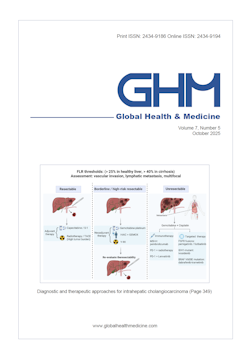Global Health & Medicine 2019;1(2):95-100.
Treatment for intractable asthma: bronchial thermoplasty.
Sugiyama H, Iikura M, Ishii S, Hojo M
Bronchial Thermoplasty (BT) is an epoch-making treatment that reduces bronchial smooth muscle by using a bronchoscope to reach the basket catheter to the bronchus and directing high-frequency current directly into the bronchi. In GINA Guidelines 2019, BT is considered to be additional treatment at Step V (the most severe), and the evidence level is B. The Japanese guidelines (JGL) also added BT as a treatment for Step 4, but it is reserved because there are still unclear points regarding long-term efficacy and safety. In Japan, as of April 1, 2019, 672 treatments were performed at 123 institutions nationwide. The average age of patients was 54.1 years, but 84 cases were over 70 years old. The average value of %FEV1 was 78.2%, but there were 94 cases less than 60%. There were 32 cases that underwent BT treatment at our institution. Of them, 12 cases with progress up to one year later could be observed. The average age was 56.1 years old, and each of 6 men and women had a %FEV1 of 70.5%. One year later, AQLQ and %FEV1 improved, and the number of exacerbations decreased, but exhaled NO values increased. %FEV1 improvement might be due to poorer lung function (70.5% vs. 77.8%) and more BT activation (average 1.28 times AIR2) compared to the AIR2 trial. In terms of improvement in %FEV1, patients with moderate obstructive disorder from 50 to 80% responded well after BT treatment. In the near future, various new antibody preparations such as IL-4 / 13 antibody and anti-TSLP antibody are expected to be promoted. Therefore, we first consider whether these antibody preparations can be applied to patients with refractory asthma. We consider that BT is indicated only when there is no indication or no expected effect of antibody preparations. In other words, BT treatment is the last resort of intractable asthma, and it is the duty of medical professionals involved in BT treatment to be able to advocate when it is best to give BT to such patients.
DOI: 10.35772/ghm.2019.01027







